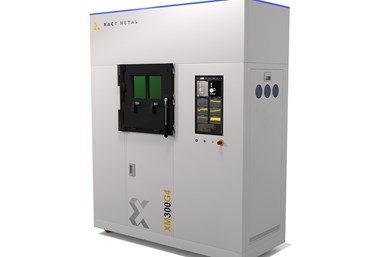Xact Metal’s XM300G 3D Printers for Large Quantities, Large Parts
The series comes in single-, dual- or quad-independent laser system models with 100% overlapping print zones that are said to offer industrial speed and performance.
Xact Metal says its XM300G series of midsize metal 3D printers is well suited for printing high quantities or large parts where print speed is critical.
The series is based on the company’s XM200G multilaser printer platform and combines the requirements of metal laser powder bed fusion with advanced technology for a new level of performance.
The XM300G comes in single-, dual- or quad-independent laser system models with 100% overlapping print zones that are said to offer industrial speed and performance, enabling small- to medium-sized companies to benefit from metal LPBF technology.
The models feature a 300 × 300 × 350 mm build volume, which is upgradable to 300 × 300 × 450 mm. The models also feature a selection of 400 W or 700 W fiber lasers, and an interchangeable build platform to reduce printing cycle time, making the system well-suited for a variety of additive manufacturing applications.
The company says The XM300G and XM200G printers are tailored to customers who are starting their entry into metal 3D printing in various applications, including product development, manufacturing, research and education.
Related Content
-
Possibilities From Electroplating 3D Printed Plastic Parts
Adding layers of nickel or copper to 3D printed polymer can impart desired properties such as electrical conductivity, EMI shielding, abrasion resistance and improved strength — approaching and even exceeding 3D printed metal, according to RePliForm.
-
AM 101: What Is Binder Jetting? (Includes Video)
Binder jetting requires no support structures, is accurate and repeatable, and is said to eliminate dimensional distortion problems common in some high-heat 3D technologies. Here is a look at how binder jetting works and its benefits for additive manufacturing.
-
3D Printed Titanium Replaces Aluminum for Unmanned Aircraft Wing Splice: The Cool Parts Show #72
Rapid Plasma Deposition produces the near-net-shape preform for a newly designed wing splice for remotely piloted aircraft from General Atomics. The Cool Parts Show visits Norsk Titanium, where this part is made.















